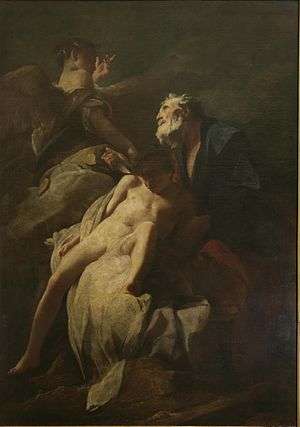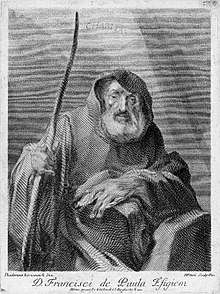Federico Bencovich
Federico Bencovich (1667 – 8 July 1753) was a prominent late Baroque painter from Dalmatia working in Italy. He is best known as Federico Bencovich or Federigo or Federighetto or Dalmatino. In modern Croatia he is known as Federiko Benković.

Life
He was born Federico Bencovich (as he signed his own name[1]) somewhere in Venetian Dalmatia. His exact birthplace is unknown, but it could have been either in Almissa (Omiš), Sebenico (Šibenik), the island of Brazza (Brač), Ragusa (Dubrovnik), or possibly Venice itself.
His initial training was likely in Venice, but later Bencovich apprenticed with Carlo Cignani in Bologna, assisting him in 1706 in completing the frescoes of the Assumption of the Virgin on the dome of the Forlì cathedral. His first independent work, Juno on the clouds, was painted in 1705. He also appears to have worked in the studio of Giuseppe Maria Crespi.
In 1710 Bencovich painted the altarpiece of St. Andrew on the cross surrounded by St. Bartholomew, St. Carolus Borromei, St. Lucia, and St. Apollonia for the church of Madonna del Piombo in Bologna, later transferred to the parish church of Senonches near Chartres in France. By 1715, he came to the service of the Archbishop-Elector of Mainz Lothar Franz von Schönborn and was to complete four large canvas masterpieces for the gallery in the Schloss Weißenstein in the town of Pommersfelden: Apollo and Marcia, Hagar and Ishmael in the Desert, Iphigenia’s sacrifice and Abraham’s sacrifice of Isaac.
Before his death, he moved to Gorizia, where he, after his death, gradually fell into oblivion. His paintings used to be attributed to Piazzetta or Cignani, amongst others.
 Bencovich's paintings Saving Saint Peter from prison
Bencovich's paintings Saving Saint Peter from prison Hagar and Ishmael in the Desert
Hagar and Ishmael in the Desert Iphigenia’s sacrifice
Iphigenia’s sacrifice Abraham’s sacrifice of Isaac
Abraham’s sacrifice of Isaac
Analysis
The dramatic, often tortured, poses and lighting of his figures are placed within earthy tenebrist backgrounds, He uses Piazzetta's and Sebastiano Ricci's unfinished and ragged brushstrokes, but superimposes a startling mystical imprint that is often foreign to the magisterial and olympian Venetian painting, and more akin to the Baroque painters from Northern Italy, Alessandro Magnasco and Francesco Cairo.
Abraham's Sacrifice of Isaac[2] is probably the painting that disappeared from the castle of Pommersfelden at the beginning of the 19th century. Until that time, the painting was attributed to Piazzetta.
Works
- Zagreb, Strossmayer Gallery, Sacrifizio d'Isacco, 1720
- Forlì, Palazzo Orselli Foschi, Giunone (Juno)
- Brescia, Pinacoteca Tosio Martinengo, Madonna in trono con santi (sketch)
- Berlin, Staatliche Museen, Madonna e santi, 1730 – 1735
- Bologna, Pinacoteca Nazionale, Il beato Pietro Gambacorta, incisione, c. 1728
- Borgo San Giacomo, Verolanuova, Brescia, Chiesa del Castello: Deposizione, c. 1735
- Crema, Church of the Holy Trinity: Estasi di S. Francesco da Paola, 1724
- Pommersfelden, Weißenstein Castle, Hagar and Ishmael in the desert; The Sacrifice of Iphigenia, c. 1715.
- Senonches, France, parish, Crucifixion of St. Andrew and Saints, c. 1725
- Stuttgart, Staats-Galerie, Adoration of the Magi, c. 1725
- Tomo, Feltre, parish, Fuga in Egitto, c. 1709
- Venice, Church of S. Sebastiano: Il beato Pietro Gambacorta, c. 1726
- Venice, Gallerie dell'Accademia, Autoritratto, c. 1735
- Venice, Museo Correr, Fuga in Egitto, drawings, c. 1720
- Vienna, Albertina: Departing for Egypt, Rest while escaping in Egypt, c. 1745; drawings: St. Francis of Paola; Ecstasy of St. Francis of Assisi; Death of St. Benedict
References
- The History of Painting in Italy, Translated from the Italian of Abate Luigi Lanzi by Thomas Roscoe, New Edition Revised, 1847, From the Period of the Revival of Fine Arts to End of Eighteenth Century, Volume 3, p. 166
- Now in the Strossmayer gallery in Croatia, after they bought the painting at a London auction in 1936.
External links
| Wikimedia Commons has media related to Federiko Benković. |